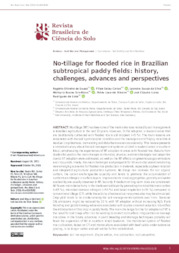No-tillage for flooded rice in Brazilian subtropical paddy fields: history, challenges, advances and perspectives.
No-tillage for flooded rice in Brazilian subtropical paddy fields: history, challenges, advances and perspectives.
Author(s): SOUSA, R. O. de; CARLOS, F. S.; SILVA, L. S. da; SCIVITTARO, W. B.; RIBEIRO, P. L.; LIMA, C. L. R. de
Summary: No-tillage (NT) has been one of the main advances related to soil management in Brazilian agriculture in the last 30 years. However, its full adoption in lowland areas that are traditionally cultivated with flooded rice is still incipient (<5 %). The main reasons are associated with the soil hydromorphic condition and the management of highly recalcitrant residual crop biomass, demanding soil disturbance even occasionally. This review presents a historical survey about the soil management systems utilized in lowland areas in southern Brazil, emphasizing the experiences of NT adoption in areas with flooded rice. Results from studies focused on the main changes in chemical, physical, and microbiological soil properties due to NT adoption were addressed, as well as the NT effects on greenhouse gas emissions and crop yields. Finally, the main challenges and prospects for NT were discussed considering new emerging scenarios for flooded rice production in lowlands, especially soybean rotation and integrated agricultural production systems. No-tillage can increase the soil organic carbon, the cation exchangeable capacity and tends to promote the accumulation of nutrients as nitrogen in surface layers. Improvements in soil aggregation, porosity and water availability are usually observed in NT, but only if medium or long-term trials are considered. NT favors microbial activity in the shallower soil layer by promoting microbial biomass carbon (+45 %), microbial biomass nitrogen (+54 %) and basal respiration (+54 %) compared to conventional tillage (CT), while the activity of extracellular enzymes also may be stimulated. Crop yield tends to be similar among the soil managements systems over time. Seasonal CH4 emissions might be reduced by 21 % with NT adoption without increasing N2O. Plant breeding and geotechnology advances associated with soybean market valuation intensified the introduction of this crop in paddy fields. The main challenge for the full adoption of NT is the need for soil tillage after rice harvesting to correct soil surface irregularities or manage rice straw. In the future, advances in plant breeding and drainage techniques probably will favor the expansion of NT in southern Brazil lowlands. The traditional system of flooded rice cultivation, based on CT and monoculture associated with beef cattle under extensive grazing, is no longer viable and will not be further established.
Publication year: 2021
Types of publication: Journal article
Keywords: Arroz, Manejo do Solo, Oryza Sativa, Solo
Observation
Some of Embrapa's publications are published as ePub files. To read them, use or download one of the following free software options to your computer or mobile device. Android: Google Play Books; IOS: iBooks; Windows and Linux: Calibre.
Access other publications
Access the Agricultural Research Database (BDPA) to consult Embrapa's full library collection and records.
Visit Embrapa Bookstore to purchase books and other publications sold by Embrapa.

